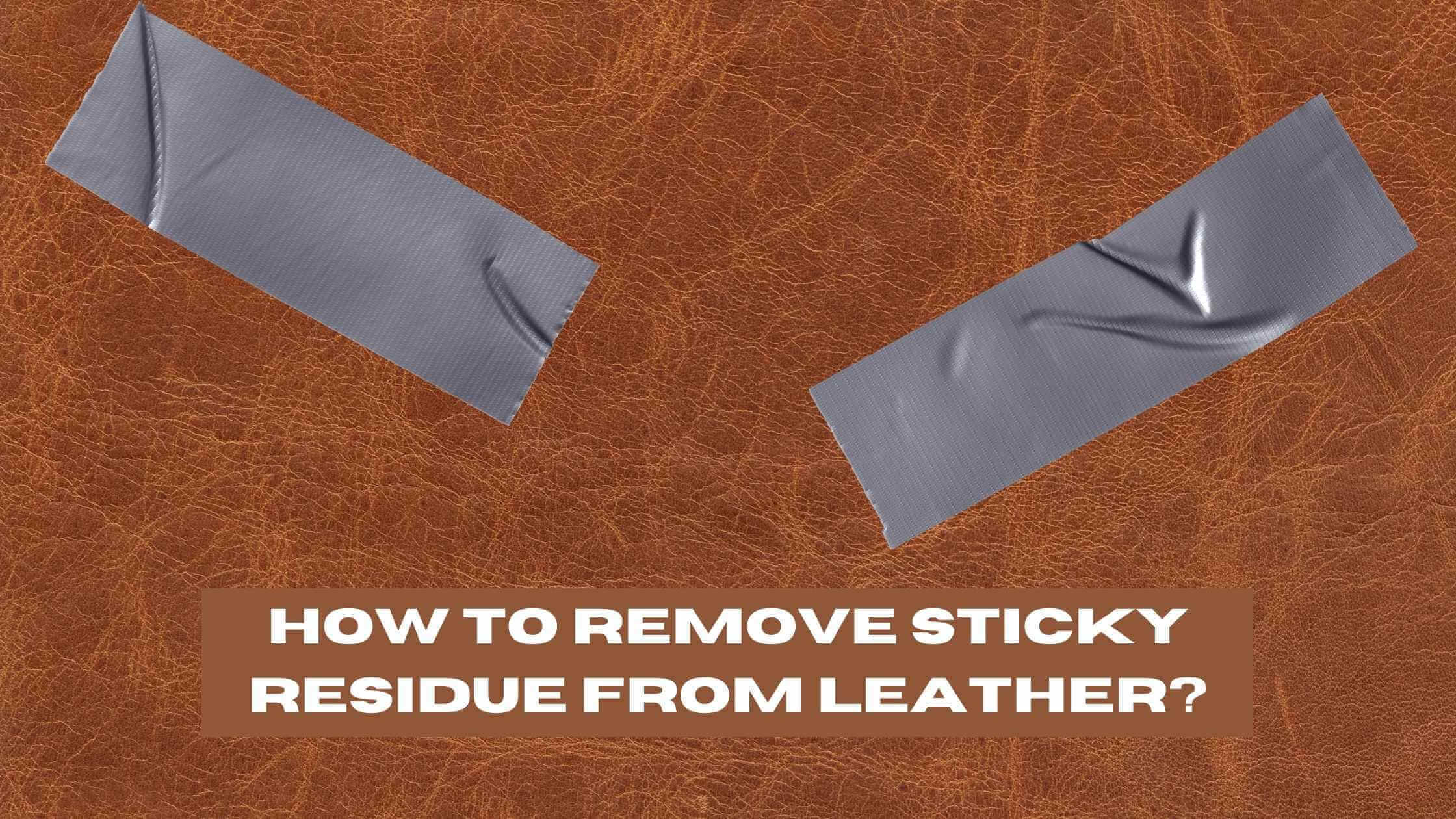Dealing with sticky residue on your favorite leather items can be quite a challenge. Whether it’s caused by tape, spills, or other mishaps, you might find yourself searching for solutions on how to clean and restore the integrity of your leather goods.
To remove sticky residue from leather, begin by gently wiping the area with a damp cloth soaked in warm, soapy water. If this doesn’t work, apply a small amount of rubbing alcohol or a commercial adhesive remover like Goo Gone onto a soft cloth and gently rub the affected area.
Always test any solution on a hidden part of the leather first to ensure it doesn’t cause damage. After removing the residue, apply a leather conditioner to restore the leather’s natural oils and protect its surface.
Methods for Removing Sticky Residue
Using Soapy Water
If you’re looking for a quick solution to remove sticky residue from your leather, warm soapy water is an effective method to start with. Mix mild dish soap with warm water, then dampen a soft cloth or sponge in the mixture. Gently scrub the affected area, being careful not to damage the leather.
After loosening the residue, wipe it away using a clean damp cloth. Rinse the area with a cloth wrung in warm water to remove any remaining soap and residue. Finish by wiping the leather dry with a microfiber towel or cloth.
Applying a Leather Cleaner
Leather cleaner is specifically formulated for use on genuine and faux leather products, making it an excellent option for removing sticky residue from your leather furniture or car seats. Apply a small amount of leather cleaner onto a soft cloth and gently rub it onto the affected area in circular motions.
Be sure to test the cleaner on a hidden area of the leather first to make sure it won’t cause any damage. Once you’ve removed the residue, follow up with a leather conditioner to keep the leather supple and protected.
Utilizing Rubbing Alcohol
Another method to remove sticky residue from leather is using rubbing alcohol. Apply a small amount of rubbing alcohol onto a clean cloth or cotton swab and dab it onto the sticky area. Be cautious, as rubbing alcohol may cause discoloration to certain leather types; always test on an inconspicuous area first.
Gently wipe away the loosened residue with a microfiber cloth or damp cloth. After you have removed the sticky substance, treat the leather with a leather conditioner to restore its natural oils and protect it from further damage.
Trying a Commercial Adhesive Remover
Commercial adhesive removers like Goo Gone can effectively remove sticky residue from leather items without damaging the material. Apply a small amount of adhesive remover to a soft cloth or sponge and gently rub it on the stained area. Ensure that you test the product on a hidden area first, as some adhesive removers may contain acetone or other abrasive ingredients that may damage certain leather types.
After removing the residue, rinse the area with a damp cloth to remove any remaining adhesive remover. Dry the leather with a clean cloth and apply a leather conditioner to maintain its natural suppleness.
Cleaning Sticky Residue From Leather Step by Step
When it comes to removing sticky residue from your leather furniture or belongings, a step-by-step approach ensures that you protect the surface and maintain its quality. Follow these steps to effectively remove sticky residue without causing damage to your leather items.
Step 1: Test in a Hidden Area
Before applying any cleaner or solution, test it on an inconspicuous part of your leather item to make sure it won’t damage or discolor the material. If the chosen method does not cause any issues, proceed with the cleaning process.
Step 2: Wipe Gently with a Damp Cloth
Dampen a soft cloth with warm water and a mild dish soap. Gently wipe the surface of the sticky leather with the soapy water, avoiding excessive scrubbing. Rinse the cloth thoroughly and wring out any excess water before wiping the area again to remove soap residue.
Step 3: Apply a Leather Cleaner or Alternative Solution
Using a leather cleaner specifically designed for genuine leather is ideal for removing sticky residue without risk of damaging the material. However, alternative solutions like baking soda paste, a mixture of equal parts water and white vinegar, or a product like Goo Gone can also be effective.
Apply the chosen cleaner with a sponge or microfiber cloth, gently rubbing the sticky area in circular motions to loosen the residue.
Step 4: Wipe and Rinse
Once the sticky residue has been loosened, use a clean, damp cloth to wipe away the cleaner and any remaining residue. Be sure to rinse the cloth as needed to ensure you are not spreading the residue to other parts of your leather item. If necessary, repeat Steps 3 and 4 until the stickiness is completely gone.
Step 5: Condition Your Leather
After successfully removing the sticky residue, apply a leather conditioner to restore the natural oils and maintain the suppleness of your leather. Using a soft cloth, apply the conditioner evenly over the entire surface of your item, avoiding direct sunlight while it dries.
Now that you know how to remove sticky residue from leather products, you can confidently and effectively manage spills, stains, and residue buildup on your leather furniture, car seats, or personal belongings.
Condition and Protect the Leather
After removing the sticky residue from your leather furniture, it is crucial to condition and protect the material to maintain its beauty and longevity. Leather conditioner helps to replenish the natural oils in genuine leather and keeps it soft and supple.
To apply the leather conditioner, dab a small amount onto a clean, soft cloth and gently massage it into the leather using circular motions. Ensure that you cover all parts of your leather item, focusing particularly on areas where the sticky adhesive residue was removed. Be careful not to oversaturate the leather, as this may cause further damage.
Allow the conditioner to absorb into the leather for a few minutes before wiping away any excess product with a clean, dry cloth. Avoid exposing the treated leather to direct sunlight, as this can lead to discoloration or fading.
In addition to conditioning, regular cleaning can help prevent the buildup of dirt, stains, and body oils that can cause your leather to become sticky.
Preventing Future Sticky Residue
To prevent sticky residue from forming on your leather furniture or other leather items, you should take a few precautions. By practicing good maintenance and being mindful of the substances that come in contact with your leather, you can keep it looking and feeling its best.
- Wipe up spills immediately: Accidents happen, but when it comes to leather, it’s essential to remove spills and stains as soon as possible. The longer a spill sits on your leather, the more likely it is to leave behind a residue or cause staining.
- Choose appropriate care products: When cleaning or conditioning your leather, be sure to use products specifically designed for leather or gentle, natural alternatives like mild dish soap and warm water. Abrasive cleaners and aggressive household products can damage the leather and leave behind sticky residue.
- Avoid direct sunlight and heat: Excessive heat and prolonged exposure to direct sunlight can dry out leather, making it more susceptible to stickiness and other issues. Keep your leather furniture and items away from direct sunlight and sources of extreme temperatures, such as heaters or air vents.
For car leather, consider using a vinyl and leather conditioner specifically designed for automotive interiors. This can help prevent sticky residue from body oils, perspiration, or other substances that may come in contact with your car’s leather seats. Similarly, be cautious with adhesive products like tape or stickers, which can leave a sticky adhesive residue if left on leather surfaces for too long.
When handling leather items, always make sure your hands are clean and free of substances like oils, lotions, or creams that could transfer to the leather and create a buildup of residue over time. It’s also a good idea to periodically vacuum and dust your leather furniture, as dirt and debris can contribute to stickiness and other issues.
Keep in mind that not all cleaners and methods will be suitable for every type of leather, and some may damage the leather if not used correctly. It’s essential to familiarize yourself with your leather items’ specific care instructions to ensure their longevity.
When in doubt, consult a professional cleaning service or seek advice from the manufacturer. Armed with this knowledge, you can now confidently remove sticky residue from your leather surfaces without causing harm and keep them in the best possible condition.

